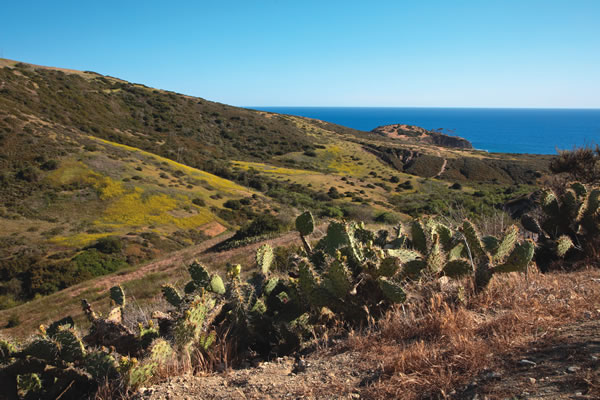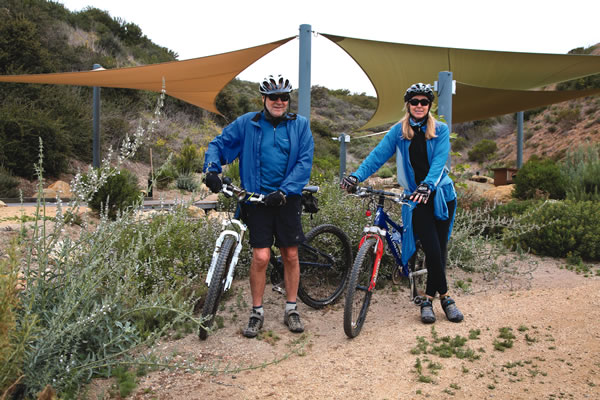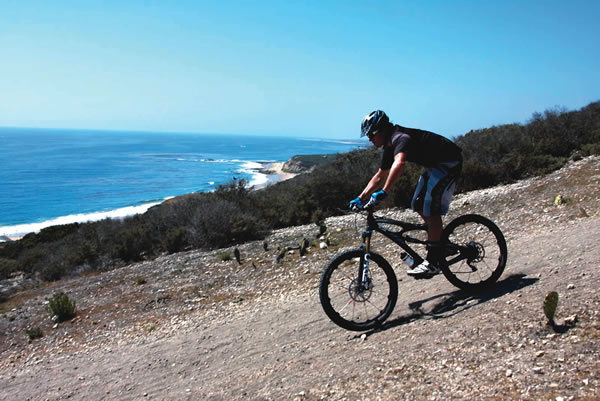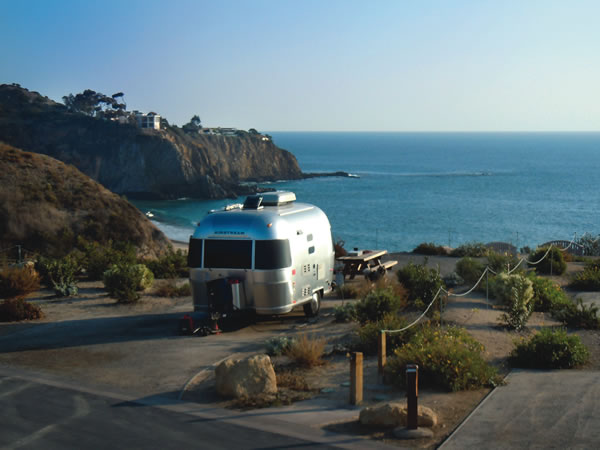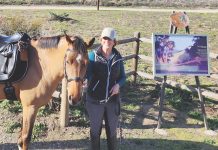From mini field science stations to evening campfires in the amphitheater, Moro Canyon has everything.
By Sharael Kolberg
Driving down Pacific Coast Highway between Laguna Beach and Corona del Mar, you may catch a glimpse of the tents and RVs perched on the cliffs of the relatively new Moro Campground located in Crystal Cove State Park. But what most people don’t see is the many ways in which the 2,400 acres of undeveloped open space is kept in its pristine, natural environment. Likewise, not many see the efforts by locals, nonprofits and philanthropists to create new opportunities for the community to not only enjoy the space through activities like mountain biking, hiking, picnicking and camping, but also become involved in the area’s preservation.
Restoring the Ecosystem
In 2006, the Moro Beach Trailer Park, with nearly 300 permanent manufactured homes, was removed to start construction of the Moro Campground and day-use facility, and ever since, the state park has seen significant improvement in the environment.
“[California] State Parks worked hard to restore 35 acres in the Moro Canyon area with the goal of increasing public access and improving the natural condition in the area,” says Todd Lewis, Crystal Cove State Park superintendent.
The renovation included not only removal of the homes but also of the outdated power, sewer (which had contaminated Moro Creek) and water infrastructures. The park staff also helped restore the ecosystem by planting 18,000 native plants (even more have been added since then). It appears the efforts are having a positive effect. According to Todd, members of the National Audubon Society recently identified more than 100 species of plants in the area, and it is not uncommon to have sightings of bobcats, reptiles, roadrunners and numerous types of birds.
Mountain bikers, like Laguna Beach resident Tony Zentil, often encounter wildlife while exploring the many miles of single-track trails. “People have no idea of how many animals you’ll see on the trails,” Tony says. “Especially in the early morning or at dusk … coyote, deer, the occasional bobcat and plenty of small animals too—rabbits, squirrels … and snakes.”
Tony is lucky to live within riding distance of the park entrance and enjoys going for a ride twice a week. “I love how the wilderness extends all the way to the coast, in many areas with no development in between,” he says.
Citizen Science
In 2011, the same year that Moro Campground opened, the Crystal Cove Alliance (CCA), a nonprofit dedicated to education, conservation and restoration, joined forces with Crystal Cove State Park to help further improvements to Moro Canyon. One of the many improvements includes the installation of the Berns Environmental Study Loop, the first of its kind going into a state park. The half-mile loop will include several mini field stations where visitors can become “citizen scientists” by utilizing features of the stations to turn ordinary hikes into exciting investigations—studying birds, plants, animal tracks and even ants—to learn more about the canyon and its natural environment.
“CCA is excited to create something unique and different to bring the community to the area and let [the community] get involved in the restoration and preservation of Moro Canyon,” says Harry Helling, president and CEO of CCA.
Laguna Beach residents Tricia and Michael Berns made the study loop possible through a generous $1 million donation. After six years of discussions with state parks, CCA is helping to turn their dream into a reality by working with the state park to design and construct the study loop, which is set to open in October of this year.
“Tricia and I hike and mountain bike two or three times per week in Moro Canyon,” Michael says. “A short drive from our home, we realized we could be in nature and observe many plants and animals and spectacular scenic vistas. The study loop is our legacy project. We believe it is important for school-age children to learn the importance of protecting our environment, the interactions of plants and animals and have knowledge of nature, and we believed that students would be more motivated in this setting than sitting in a classroom.”
According to Michael, approximately $500,000 of their donation will be used to build the infrastructure located near the parking lot in Moro Canyon. This will include a small pavilion for student staging, a better and more usable amphitheater with a fire pit, interactive displays along the study loop, ramadas (picnic table areas) that will be turned into citizen science field stations, and other items important for the development of the study loop. The other 50 percent of the donation has been put into a charitable fund at the Laguna Beach Community Foundation, where CCA hopes to eventually add another $1 million to address ongoing maintenance and endow a full-time education position.
Focusing on various disciplines, the new citizen science field stations will include a wide variety of learning experiences such as observing birds with a telescope from a bird blind, counting brilliantly colored harlequin bugs in a study on symbiosis, searching for plants used by Moro’s earliest Native American residents, using a viewing tube to study an eroding cliff face, studying animal tracks using sand pits and trapcams, studying wind and weather utilizing a new sophisticated sensors, using cellphones and social media to collect and share images of birds and reptiles to find out if restoration is working, checking creek traps for invasive frogs and much more.
CCA will also work with local universities and schools to further research and engagement with the community. One of the stations, for example, works in partnership with UC Irvine. Travis E. Huxman, professor of ecology and evolutionary biology and director of the Center for Environmental Biology at the university, is developing a component of their research program at one of the Moro Canyon field science stations that focuses on the “ecohydrology” of landscapes (the study of the interactions between water and ecosystems).
At the center, UC Irvine students will attempt to answer the question: “Where does all the water go?” by collecting data in order to create a “balance sheet” of the behavior of water. Travis says that using the citizen science approach to actively engage K-12 students in science is likely to create a better understanding of these water processes while helping students meet classroom objectives.
“Through this experience,” Travis says, “I hope that these students develop both environmental and scientific literacy and are motivated to use that knowledge as they become citizens of the world and realize how different actions they may take as stewards of the land influence water quality and quantity.”
Dr. Al Bennett, dean of the UC Irvine School of Biological Sciences and CCA board member, has also been involved in creating the study loop. He is particularly interested in developing the next generation of STEM (science, technology, mathematics and engineering) K-12 teachers. “The study loop will be one resource for our undergraduate teachers to involve their students in the environmental science going on locally, and hopefully to encourage their ongoing participation in that work,” Al says.
Connecting With Nature
While Moro Canyon is a great place for schoolchildren and researchers to learn about the environment, its 17 miles of backcountry trails also gives everyone from hikers and mountain bikers to equestrians the opportunity to learn about the area while enjoying it recreationally. Harry points out that park visitors can protect and save the open space by understanding it. “Visitors can enhance their experience on trails by being aware of how the ecosystems work,” he says. “Don’t just pass through, but be a part of the environment.”
Local hiker Shannon Horton enjoys taking her 10-year-old daughter Grace hiking at Moro Canyon. “I make sure I point out to her little and big details I discover or find interesting. She then chimes in with her own observations,” Shannon says.
When Grace is in school, Shannon enjoys taking advantage of the trails to focus on fitness. “I love outdoor fitness in a beautiful, clean setting,” Shannon adds. “I have hiked in Tahoe many times, which is quite different … higher elevation, forestry and high meadows. Moro Canyon is mainly scrubby and dry with a killer ocean view.”
To make the most of hiking in the area, Shannon recommends starting early, layering, wearing sunscreen and a hat, bringing water, watching the trail for snakes in warm weather and carrying a cellphone for safety reasons only (not chatting).
Laguna Beach resident Sandra Wolfson also enjoys hiking the trails. Having grown up with a father that was a state park ranger, she is no stranger to exploring open space. “My dad would tell us all the Latin names of all the plants while we hiked,” Sandra recalls.
These days she relishes the fact that Moro Canyon trails are easy to access and provide ocean views at every turn. “When I’m feeling like I need a workout, I like to climb high to get the ocean views, but when I need a short stroll and fresh air I stay low,” Sandra adds. “Moro Canyon Trail is beautiful. It winds its way through the canyon’s bottom where water flows in Moro Creek and wild flowers grow along its edge.”
Sandra makes the most out of her hiking experience by bringing friends and a big lunch with chocolate or sweets. As an artist, she also sometimes brings a sketch pad to gain inspiration for her artwork.
For children, grandparents, or any age in between, there is surely something interesting to be found in Moro Canyon. And, with the new Berns Environmental Study Loop opening in October, whether it’s attending a campfire or stargazing party at the new ampitheater, hiking on the trails, helping park scientists count birds or just sitting and enjoying the stillness and beauty, it’s worth slowing down to take a look at what’s happening just off of Coast Highway at Moro Canyon in Crystal Cove State Park. LBM


